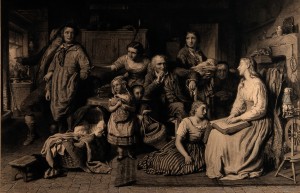 Touching the Book: Embossed Literature for Blind People in the Nineteenth Century
Touching the Book: Embossed Literature for Blind People in the Nineteenth Century
Where: Peltz Gallery, Ground Floor, School of Arts, Birkbeck, London WC1H 0PD
When: 18 July – 30 October 2013, Monday-Friday 9-5. No booking required
This free exhibition explores the history of literacy for blind and
visually impaired people in nineteenth-century Britain and Europe
through the development of embossed literature. It introduces visitors
to the variety of embossed writing systems that blind people were taught
prior to the widespread adoption of braille at the end of the
nineteenth century. There was fierce debate in this period between
educators who favoured a system based on the Roman alphabet that could
be read still by sight and those who advocated for an arbitrary system –
such as braille – more suited to finger reading.
Touching the book: Embossed literature for Blind People brings
together a rich array of material, including important examples of
early classbooks, spiritual guides, the first specially-commissioned
embossed Bibles, writing devices, pamphlets and visual images. It details
how early embossing attempts were motivated by religious desire to
enable blind people to read the word of God directly through touch. This
fuelled investment in embossing processes which in turn improved the
quality and durability of embossed books.
Most significantly however, the development of finger-reading
practices helped to create new communities of literate blind and
visually-impaired people who began advocating for reading and writing
systems best suited to the needs of blind people. The exhibition
highlights individuals in the nineteenth-century blind community who
both raised the profile of and were instrumental in improving literacy
for blind and visually-impaired people, including Laura Bridgman,
William Moon, G.A. Hughes, Louis Braille and Thomas Rhodes Armitage.
Here on this website you can find out visitor information (how to get
to the exhibition, opening hours, facilities, tours), as well as learn
more about the exhibition objects. There is also a forum for people to
share knowledge and experience relating to the exhibition’s themes of
visual disability and literacy, and we very much welcome contribution
and comment.
Aucun commentaire:
Enregistrer un commentaire